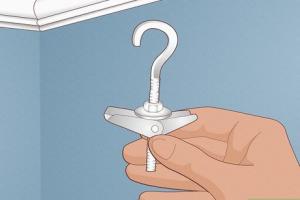Mastering the Art of Hanging Hooks from Ceilings: A Comprehensive Guide

-
Quick Links:
- 1. Introduction
- 2. Why Hang Hooks from Ceilings?
- 3. Types of Hooks
- 4. Tools and Materials Needed
- 5. Preparation Steps
- 6. Step-by-Step Guide to Hanging Hooks
- 7. Safety Tips
- 8. Case Studies
- 9. Expert Insights
- 10. FAQs
- 11. Conclusion
1. Introduction
Hanging hooks from ceilings can serve various purposes, from decor to practical storage solutions. Whether you're looking to hang plants, lighting fixtures, or artwork, learning how to do it correctly is essential. This comprehensive guide will walk you through the entire process, ensuring you can confidently and safely hang hooks from your ceiling.
2. Why Hang Hooks from Ceilings?
Hanging hooks from ceilings provides several advantages:
- Space-saving: Utilizing vertical space can help declutter your floors and surfaces.
- Versatile use: Hooks can be used for a variety of items, including plants, light fixtures, and storage solutions.
- Decorative appeal: Well-placed hooks can enhance the aesthetic of your space.
3. Types of Hooks
Understanding the different types of hooks is vital for choosing the right one for your project:
- Standard Ceiling Hooks: Simple hooks for hanging lightweight items.
- Screw-in Hooks: Designed for heavier items, screw-in hooks provide added security.
- Swag Hooks: Used for hanging chandeliers or decorative pieces in a swag style.
- Plant Hangers: Specifically designed for hanging plants, often come with chains or macramé designs.
4. Tools and Materials Needed
Before starting your project, gather the following tools and materials:
- Drill
- Drill bits
- Stud finder
- Screwdriver
- Measuring tape
- Level
- Hooks (appropriate for your project)
- Safety goggles
- Step ladder
5. Preparation Steps
Proper preparation is key to a successful installation:
- Choose the Right Location: Determine where you want the hook to be placed, considering aesthetics and functionality.
- Use a Stud Finder: Locate ceiling joists to ensure you hang the hook securely.
- Measure and Mark: Use a measuring tape to mark the exact spot where the hook will go.
6. Step-by-Step Guide to Hanging Hooks
Follow these steps for a successful installation:
- Drill a Pilot Hole: Using a drill bit slightly smaller than your hook, drill a pilot hole into the marked spot.
- Insert the Hook: If using a screw-in hook, twist it into the pilot hole manually or with a screwdriver.
- Check for Stability: After installation, gently tug on the hook to ensure it is secure.
7. Safety Tips
Safety should always be a priority:
- Wear safety goggles to protect your eyes from debris.
- Use a sturdy ladder and ensure it is placed on a flat surface.
- Do not exceed the weight limit of the hook.
8. Case Studies
Here are a few examples of successful hook installations:
- Living Room Plant Hangers: A homeowner used ceiling hooks to hang multiple plants, transforming a dull corner into a vibrant green space.
- Chandelier Installation: An interior designer used swag hooks to hang a chandelier in a dining room, creating a stunning focal point.
9. Expert Insights
We consulted with home improvement experts to gather their insights on hanging hooks:
Expert Tip: Always ensure you’re drilling into a stud for heavy items. If you can’t find a stud, use a toggle bolt for extra support.
10. FAQs
FAQs
1. What weight can ceiling hooks hold?
The weight capacity of ceiling hooks varies. Standard hooks can hold up to 20 pounds, while heavy-duty hooks can support 50 pounds or more.
2. Can I hang a ceiling hook without a stud?
Yes, you can use toggle bolts or molly bolts to secure hooks in drywall without studs.
3. What tools do I need to install ceiling hooks?
You’ll need a drill, drill bits, a screwdriver, a stud finder, and a level.
4. How high should I hang my hooks?
This depends on what you plan to hang. Generally, hooks should be at least 6-12 inches above the item to allow for clearance.
5. Can I use decorative hooks for heavy items?
Only if they are rated for the weight. Always check the manufacturer's specifications.
6. How do I keep my hooks from loosening over time?
Regularly check the hooks and tighten them if needed. Use lock washers for added security.
7. What materials are best for ceiling hooks?
Metal hooks are generally the strongest. Ensure they are rust-resistant if used in humid areas.
8. Can I hang lights from ceiling hooks?
Yes, as long as the hooks are rated for the weight of the light fixture.
9. How do I remove a ceiling hook?
Simply unscrew it counterclockwise. If it’s embedded in drywall, you may need to patch the hole afterward.
10. Are there special hooks for hanging plants?
Yes, many hooks are designed specifically for plants and come with chains or macramé options.
11. Conclusion
Hanging hooks from ceilings is a simple yet effective way to enhance your home’s functionality and style. By following the steps outlined in this guide, you can confidently install hooks that serve both practical and decorative purposes. Happy DIY-ing!
External References
- Home Depot - How to Hang a Ceiling Hook
- Family Handyman - How to Hang a Chandelier
- The Spruce - FAQs About Hanging Plants
Random Reads
- Mastering google drive uploading files
- Mastering gmail on iphone
- How to know if your gmail has been hacked
- How to kill mold spores
- Quick easy verizon sim activation guide
- Quick guide transfer photos ipad
- How to set browser homepage yahoo
- How to set different wallpapers on dual monitors
- How to replace office chair casters
- Open up storage space iphone